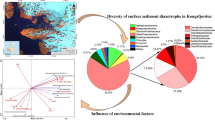Sediments often exhibit low rates of nitrogen fixation, despite the presence of elevated concentrations of inorganic nitrogen. The organisms that potentially fix nitrogen in sediments have not previously been identified. Amplification of nifH genes with degenerate primers was used to assess the diversity of diazotrophs in two distinct sediment systems, anoxic muds of Chesapeake Bay and shallow surficial sediments of the Neuse River. Phylogenetic analysis revealed that sequences obtained from mid-Chesapeake Bay, which receive high organic loading and are highly reducing, clustered closely with each other and with known anaerobic microorganisms, suggesting a low abundance of aerobic or facultative diazotrophs in these sediments. Sulfate reduction dominates in the surface, but methanogenesis becomes more important with depth. A thin (<1 cm) oxidized layer is present only in the spring. No archaeal nifH sequences were obtained from Chesapeake Bay. Sequences of nifH amplified from surficial sediments of the Neuse River were distant from Chesapeake Bay sequences and included nif phylotypes related to sequences previously reported from marine mats and the Spartina rhizosphere. Differences in environmental site characteristics appear to select for different types of sediment diazotrophs, which is reflected in the phylogenetic composition of amplified nifH sequences.
Similar content being viewed by others
Author information
Authors and Affiliations
Rights and permissions
About this article
Cite this article
Burns, J., Zehr, J. & Capone, D. Nitrogen-Fixing Phylotypes of Chesapeake Bay and Neuse River Estuary Sediments . Microb Ecol 44, 336–343 (2002). https://doi.org/10.1007/s00248-002-1000-9
Received:
Accepted:
Issue Date:
DOI: https://doi.org/10.1007/s00248-002-1000-9



